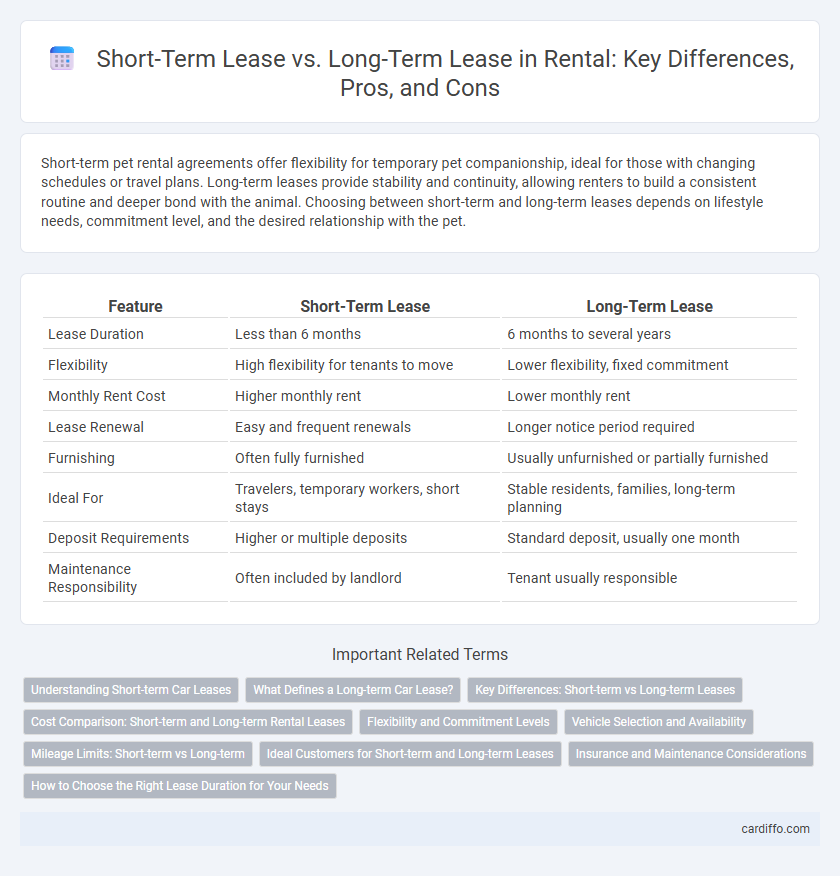Short-term pet rental agreements offer flexibility for temporary pet companionship, ideal for those with changing schedules or travel plans. Long-term leases provide stability and continuity, allowing renters to build a consistent routine and deeper bond with the animal. Choosing between short-term and long-term leases depends on lifestyle needs, commitment level, and the desired relationship with the pet.
Table of Comparison
| Feature | Short-Term Lease | Long-Term Lease |
|---|---|---|
| Lease Duration | Less than 6 months | 6 months to several years |
| Flexibility | High flexibility for tenants to move | Lower flexibility, fixed commitment |
| Monthly Rent Cost | Higher monthly rent | Lower monthly rent |
| Lease Renewal | Easy and frequent renewals | Longer notice period required |
| Furnishing | Often fully furnished | Usually unfurnished or partially furnished |
| Ideal For | Travelers, temporary workers, short stays | Stable residents, families, long-term planning |
| Deposit Requirements | Higher or multiple deposits | Standard deposit, usually one month |
| Maintenance Responsibility | Often included by landlord | Tenant usually responsible |
Understanding Short-term Car Leases
Short-term car leases typically range from one to twelve months, offering flexibility for individuals needing a vehicle without long-term commitment. These leases often include higher monthly payments compared to long-term leases but allow renters to avoid depreciation worries and costly maintenance. Understanding terms like mileage limits, insurance requirements, and end-of-lease conditions is crucial for maximizing the benefits of short-term car leasing.
What Defines a Long-term Car Lease?
A long-term car lease typically spans 24 to 48 months, offering lower monthly payments compared to short-term leases, which usually last less than 12 months. This extended duration provides lessees with stability and the opportunity to build equity or benefit from potential lease-end purchase options. Lease agreements for long-term terms often include mileage limits ranging from 10,000 to 15,000 miles per year, influencing overall cost based on usage.
Key Differences: Short-term vs Long-term Leases
Short-term leases typically range from a few days to several months, offering flexibility and higher monthly rent compared to long-term leases that last a year or more, providing stability and lower monthly costs. Short-term agreements are ideal for temporary housing needs, while long-term leases suit tenants seeking consistent residence and landlord-tenant relationship continuity. Renters should consider factors like rental price, lease duration, and the need for adaptability when choosing between short-term and long-term lease options.
Cost Comparison: Short-term and Long-term Rental Leases
Short-term leases typically carry higher monthly rental rates compared to long-term leases due to flexibility and convenience factors, often ranging from 10% to 30% more in cost. Long-term leases benefit from discounted rates and predictable expenses, making them more cost-effective for tenants seeking stability over extended periods. Understanding the price differential and potential hidden fees, such as utilities or maintenance costs, is essential for an accurate cost comparison between short-term and long-term rental agreements.
Flexibility and Commitment Levels
Short-term leases offer high flexibility, allowing tenants to adapt quickly to changing circumstances without long-term obligations. Long-term leases provide greater stability and lower monthly rates but require a significant commitment, often spanning 12 months or more. Choosing between these options depends on the tenant's need for flexibility versus a preference for predictability and cost savings.
Vehicle Selection and Availability
Short-term leases offer greater flexibility in vehicle selection as they cater to immediate needs and often include a diverse fleet with the latest models readily available. Long-term leases may limit vehicle variety but typically provide more consistent availability and lower monthly costs for popular models. Choosing between short-term and long-term leases depends on balancing the need for specific vehicles against budget constraints and duration of use.
Mileage Limits: Short-term vs Long-term
Short-term leases typically offer higher mileage limits or unlimited miles, catering to renters with temporary or sporadic use needs, while long-term leases impose stricter annual mileage caps to control vehicle depreciation and maintenance costs. Exceeding mileage limits in long-term leases often results in significant extra fees, making it essential for lessees to accurately estimate their driving distance. Short-term leases provide greater flexibility for higher mileage without penalty, which suits short-duration rentals or travel.
Ideal Customers for Short-term and Long-term Leases
Short-term leases appeal to transient professionals, tourists, and individuals in need of flexible housing solutions due to temporary work assignments or travel, offering convenience and minimal commitment. Long-term leases attract stable tenants such as families, business employees, and students seeking consistent housing with predictable rent and the ability to personalize their living space. Understanding the target demographics aids landlords in tailoring lease agreements to meet customer needs and maximize occupancy rates.
Insurance and Maintenance Considerations
Short-term leases typically require renters to secure their own insurance coverage due to limited landlord responsibility, while long-term leases often include landlord-provided insurance policies that cover certain damages. Maintenance obligations differ as well; short-term lease tenants generally handle minor repairs independently, whereas long-term leases assign most maintenance duties to the landlord, ensuring consistent property upkeep. Understanding these insurance and maintenance distinctions is crucial for tenants to manage risks and avoid unexpected costs during rental agreements.
How to Choose the Right Lease Duration for Your Needs
Choosing the right lease duration depends on factors such as your financial stability, mobility, and long-term plans. Short-term leases offer flexibility and are ideal for temporary stays or uncertain situations, while long-term leases generally provide lower monthly rent and greater stability for permanent residents. Evaluating your lifestyle priorities and budget will guide you in selecting the optimal lease term that balances cost savings with flexibility.
Short-term lease vs long-term lease Infographic

 cardiffo.com
cardiffo.com